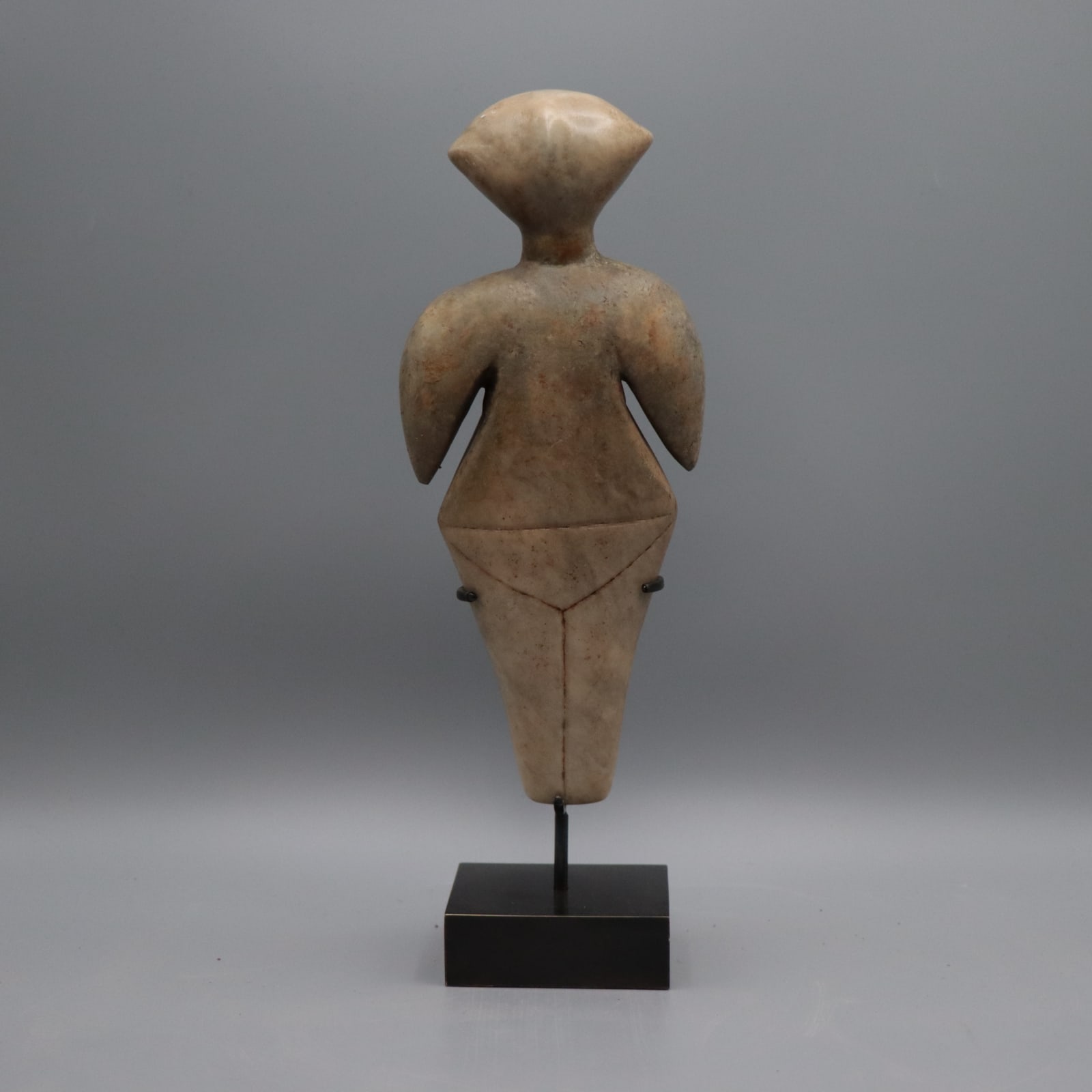Anatolian Kilia-Type Figure ('Stargazer'), 4000 BC to 3000 BC
Marble
24.2 x 10.3 x 4.4 cm
9 1/2 x 4 x 1 3/4 in
9 1/2 x 4 x 1 3/4 in
LI.3247
An exceptionally rare and remarkably well preserved Anatolian fertility figure dating to the Neolithic period. A culture very much related to that of the Cyclades existed in the Levant during...
An exceptionally rare and remarkably well preserved Anatolian fertility figure dating to the Neolithic period.
A culture very much related to that of the Cyclades existed in the Levant during the later Neolithic period. A preference for highly schematic and reductive figurines, predominantly female, is also very common to both. These female figurines represent in all probability the Mother Goddess and are linked to notions of fertility, while their schematic simplicity is typical of the Neolithic Age, when they were made in a variety of materials. The fact that such figurines have been unearthed in urban surroundings and small domestic shrines suggests that they were used for daily worship purposes.
In the Levant, this style of figure continued, with regional variations, long after neighboring Mediterranean cultures adopted more naturalistic or elaborate styles. These sculptures represent some of the earliest attempts to represent human figures.
The present figurine has abstract iconographical characteristics, focussed on prominent hips in an hour-glass figure, schematic neck , and large arms. Simplified yet elegant expression of the pubic triangle continuing in a cut symbolically dividing the two legs. The portrayal of the pubic triangle clearly denotes then link of this figurine to fertility cults. The face is essentially triangular, with a ridge marking the nose. The smooth flat surface is devoid of any detail, featuring two wings/arms either side of a ‘tear-drop’ shaped body. The only interruption to the surface is the beak-like protrusion from the centre of the face.
The exceptional care needed to carve and smooth the stone during the Neolithic period suggests that this artefact was an elite possession, and that it probably had a non-secular function. Most early groups objectified animals, and then humans, as religious and ritual imagery, as it was these that were imbued with spiritual values, and were a more effective means of symbolizing qualities than abstract notions and concepts. What we know about society at the time suggests that there was a hierarchy that was only familiar with such otherwordly concepts at the highest level; we can therefore safely assume that thus piece was owned by, and used by, a high-ranking member of the society, and that s/he was probably involved in some ritual function within the society.
The appeal of this figure, along with its exceptional rarity, is in its quintessentially minimalistic character. This is an artefact almost 6000 years old and yet uniquely appealing to the contemporary eye and taste.
This is an artefact of truly outstanding museum quality, befitting the most distinguished collections and the most discerning collectors.
A culture very much related to that of the Cyclades existed in the Levant during the later Neolithic period. A preference for highly schematic and reductive figurines, predominantly female, is also very common to both. These female figurines represent in all probability the Mother Goddess and are linked to notions of fertility, while their schematic simplicity is typical of the Neolithic Age, when they were made in a variety of materials. The fact that such figurines have been unearthed in urban surroundings and small domestic shrines suggests that they were used for daily worship purposes.
In the Levant, this style of figure continued, with regional variations, long after neighboring Mediterranean cultures adopted more naturalistic or elaborate styles. These sculptures represent some of the earliest attempts to represent human figures.
The present figurine has abstract iconographical characteristics, focussed on prominent hips in an hour-glass figure, schematic neck , and large arms. Simplified yet elegant expression of the pubic triangle continuing in a cut symbolically dividing the two legs. The portrayal of the pubic triangle clearly denotes then link of this figurine to fertility cults. The face is essentially triangular, with a ridge marking the nose. The smooth flat surface is devoid of any detail, featuring two wings/arms either side of a ‘tear-drop’ shaped body. The only interruption to the surface is the beak-like protrusion from the centre of the face.
The exceptional care needed to carve and smooth the stone during the Neolithic period suggests that this artefact was an elite possession, and that it probably had a non-secular function. Most early groups objectified animals, and then humans, as religious and ritual imagery, as it was these that were imbued with spiritual values, and were a more effective means of symbolizing qualities than abstract notions and concepts. What we know about society at the time suggests that there was a hierarchy that was only familiar with such otherwordly concepts at the highest level; we can therefore safely assume that thus piece was owned by, and used by, a high-ranking member of the society, and that s/he was probably involved in some ritual function within the society.
The appeal of this figure, along with its exceptional rarity, is in its quintessentially minimalistic character. This is an artefact almost 6000 years old and yet uniquely appealing to the contemporary eye and taste.
This is an artefact of truly outstanding museum quality, befitting the most distinguished collections and the most discerning collectors.
